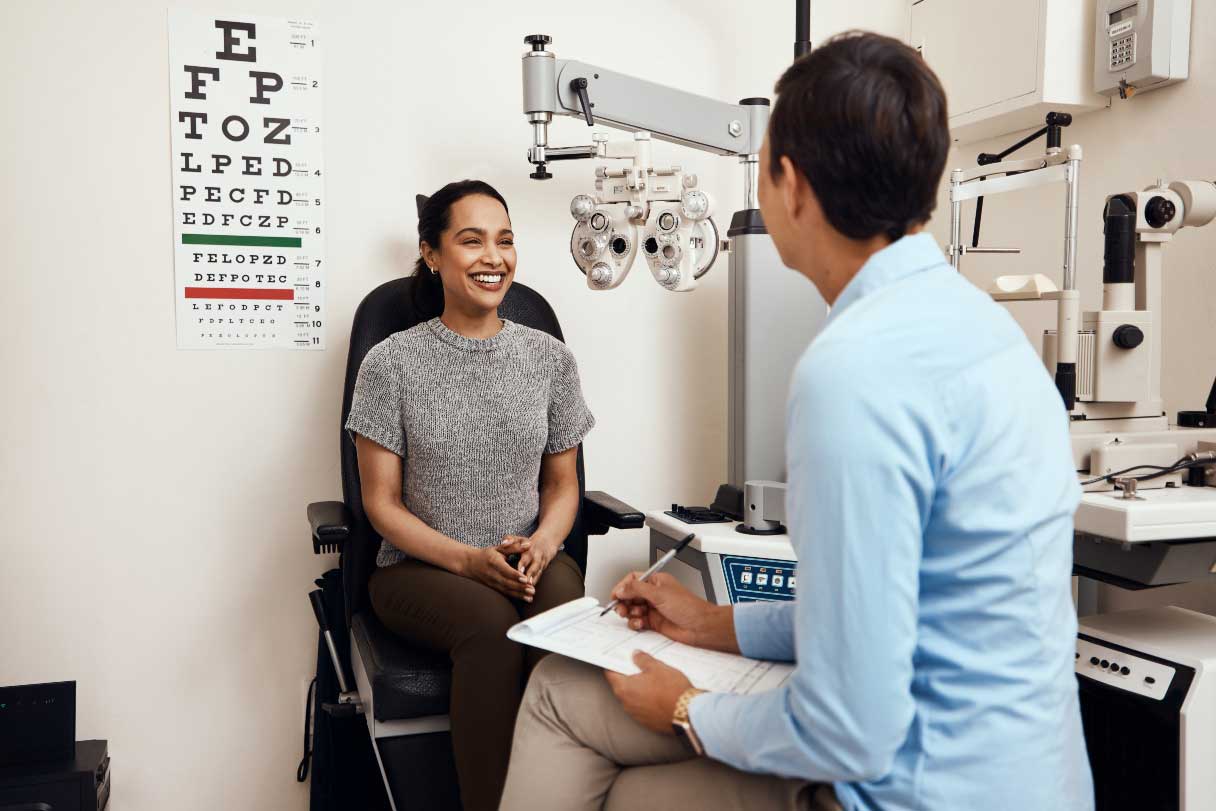If you've recently been told you have astigmatism, you're in good company. According to the American Academy of Ophthalmology, astigmatism occurs in about one out of every three people in the United States and often is seen in combination with other refractive errors such as nearsightedness or farsightedness.1
Read on to find out what astigmatism is, causes, symptoms, and different treatment options for correcting astigmatism.
What is Astigmatism?
Astigmatism is a common vision problem and refractive error that results in your vision becoming blurry. However, unlike with nearsightedness or farsightedness, astigmatism can make objects both near and far appear out of focus.
Types
There are two types of astigmatisms: corneal astigmatism and lenticular astigmatism.3
- Corneal astigmatism is caused by a distorted shape of the cornea, the transparent lens that covers the front of the eye.3
- Lenticular astigmatism occurs when the lens, the clear part of the eye located behind the iris, is misshapen.
Both types of astigmatisms will make your vision blurry, but good news—both are treatable as well.3
Symptoms
Mild cases of astigmatism might not present any symptoms at all and may only be diagnosed during a routine eye exam. More serious astigmatism cases may experience some of the following symptoms:4
- Blurred vision
- Eye strain
- Eye discomfort
- Having to squint to see clearly
- Headaches
Causes
Astigmatism is caused when the eye's cornea or the lens is irregularly shaped, usually with less curvature than normal. This shape difference of the cornea or the lens causes light to refract poorly onto your retina, distorting the vision.2
Risk Factors
While medical professionals don't know why some people have a cornea or lens that is shaped differently, leading to astigmatism, there are a handful of factors that can increase your risk for astigmatism:2
- Family history
- Eye injury
- Eye disease
- Eye surgery
Things such as staring at computer screens, sitting too close to the television, or reading in low light, however, have not been found to increase the risk of astigmatism.
Diagnosis
Even if you are suffering from any of the symptoms above, it does not necessarily mean that you have astigmatism. However, you should make an appointment with an ophthalmologist for a comprehensive eye exam.
During the appointment, the ophthalmologist will do a complete eye examination to measure how your retina is capturing and focusing light as well as to look for other potential causes of the symptoms. Oftentimes, the ophthalmologist will need to dilate your eyes during this exam.2
Astigmatism Treatment and Prevention
Yes! Astigmatism is treatable. Astigmatism can be both cured through procedures that reshape the cornea or lens, or the blurred vision can be corrected through the use of glasses or contact lenses.
How to Correct Astigmatism
Depending on the severity of the astigmatism, there are a number of eye care treatment options to consider improving your eye health.4 For very mild astigmatism cases, no treatment may be needed at all.
1. Eyeglasses
Wearing prescription eyeglasses is the easiest and least expensive option for treating astigmatism. If you have astigmatism, your eyeglasses will include a special cylinder-shaped lens that will counteract the astigmatism and help your eyes to focus correctly.2,4
2. Contact lenses
Contact lenses may be another option for correcting distorted vision due to astigmatism. Depending on the severity of your astigmatism, your eye doctor may recommend a specific type of contact lens such as a toric soft contact, hybrid contact or scleral lens contact.2,4
3. Orthokeratology
Orthokeratology (Ortho-K) is a non-surgical procedure that works to reshape the cornea by using a hard contact lens worn each night. Think of it as a kind of retainer for your eyeball. The results only last if you continue to wear the lens at night but do prevent you from having to wear contacts or glasses during the day to have clear vision.2
4. Laser and refractive surgery
Astigmatism can also be corrected with surgical procedures such as LASIK (laser in situ keratomileusis) or PRK (photorefractive keratectomy). Procedures like LASIK work to physically reshape the cornea or lens to correct the astigmatism.2
Preventing Astigmatism
Since doctors don't know exactly why the cornea or lens of those with astigmatism are irregularly shaped, there currently are no known preventative measures to avoid this condition.2
Can I Use My CareCredit Credit Card for Astigmatism Treatment?
Yes, if approved, you can use your CareCredit credit card at locations within the CareCredit network to finance vision correction products like prescription glasses or contact lenses or other vision procedures such as LASIK or PRK.* Plus, promotional financing options are available with the CareCredit credit card. If approved, you can pay for the care you need immediately. You can also use your CareCredit card again and again to pay for other health, wellness and vision care needs. Use the Acceptance Locator or download the CareCredit Mobile App to find a vision expert near you who accepts the CareCredit credit card.
Writer Bio
Kate Bayless is an experienced health and wellness freelance writer with 15 years of experience. Her work has appeared in Parents, Women's Health, Beachbody, and OpenFit.








